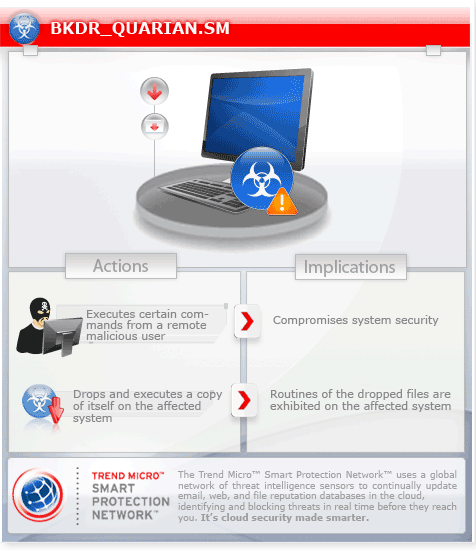BKDR_QUARIAN.SM
Windows 2000, Windows Server 2003, Windows XP (32-bit, 64-bit), Windows Vista (32-bit, 64-bit), Windows 7 (32-bit, 64-bit)


Threat Type: Backdoor
Destructiveness: No
Encrypted: No
In the wild: Yes
OVERVIEW
This malware is related to the targeted attacks leveraged against a top US government organization on December 2012. It was sent through an email claiming to be from the Syrian government. It allows the attackers to execute remote commands on the affected system, which can result in the system's security (and any information held within) being compromised.
To get a one-glance comprehensive view of the behavior of this Backdoor, refer to the Threat Diagram shown below.

For the related story, you may read the blog post QUARIAN Attacks Expand their Target
This backdoor arrives on a system as a file dropped by other malware or as a file downloaded unknowingly by users when visiting malicious sites.
It executes commands from a remote malicious user, effectively compromising the affected system.
TECHNICAL DETAILS
Arrival Details
This backdoor arrives on a system as a file dropped by other malware or as a file downloaded unknowingly by users when visiting malicious sites.
Installation
This backdoor drops the following copies of itself into the affected system and executes them:
- %User Temp%\update.exe
(Note: %User Temp% is the current user's Temp folder, which is usually C:\Documents and Settings\{user name}\Local Settings\Temp on Windows 2000, XP, and Server 2003, or C:\Users\{user name}\AppData\Local\Temp on Windows Vista and 7.)
It adds the following mutexes to ensure that only one of its copies runs at any one time:
- windowsupdataguoDL
Autostart Technique
This backdoor adds the following registry entries to enable its automatic execution at every system startup:
HKEY_LOCAL_MACHINE\SOFTWARE\Microsoft\
Windows\CurrentVersion\Run
wintinfo.exe = "%User Temp%\update.exe"
Backdoor Routine
This backdoor executes the following commands from a remote malicious user:
- Perform remote shell
- Upload file to C&C server
- Download file from C&C server
- Execute files
- Enumerate files and folders
- Move files
- Delete files
- Change C&C connection delay
- Delete the autorun registry entry HKEY_CURRENT_USER\SOFTWARE\Microsoft\Windows\CurrentVersion\Run alg
- Send the following information:
- Host name
- IP address
- OS version information
- User name
- User privelege information
It connects to the following URL(s) to send and receive commands from a remote malicious user:
- {BLOCKED}reddy1.{BLOCKED}5.com
NOTES:
It tries to execute the following files:
- %User Temp%\Readme.pdf
SOLUTION
Step 1
Before doing any scans, Windows XP, Windows Vista, and Windows 7 users must disable System Restore to allow full scanning of their computers.
Step 2
Identify and terminate files detected as BKDR_QUARIAN.SM
- Windows Task Manager may not display all running processes. In this case, please use a third-party process viewer, preferably Process Explorer, to terminate the malware/grayware/spyware file. You may download the said tool here.
- If the detected file is displayed in either Windows Task Manager or Process Explorer but you cannot delete it, restart your computer in safe mode. To do this, refer to this link for the complete steps.
- If the detected file is not displayed in either Windows Task Manager or Process Explorer, continue doing the next steps.
Step 3
Delete this registry value
Important: Editing the Windows Registry incorrectly can lead to irreversible system malfunction. Please do this step only if you know how or you can ask assistance from your system administrator. Else, check this Microsoft article first before modifying your computer's registry.
- In HKEY_LOCAL_MACHINE\SOFTWARE\Microsoft\Windows\CurrentVersion\Run
- wintinfo.exe = "%User Temp%\update.exe"
- wintinfo.exe = "%User Temp%\update.exe"
Step 4
Scan your computer with your Trend Micro product to delete files detected as BKDR_QUARIAN.SM. If the detected files have already been cleaned, deleted, or quarantined by your Trend Micro product, no further step is required. You may opt to simply delete the quarantined files. Please check this Knowledge Base page for more information.
Did this description help? Tell us how we did.

